F or Barbara Fluder, the moment came when the perfect location virtually fell into her lap. For Chad Millsap, it was more methodical, with some discouraging fits before he got his start. For DeAnne Witherspoon, enough was just enough.
Each of these O.D.s had what you might call a dream deferred: ownership of their own practices. Today, however, each has a dream come true.
Employed out of optometry school by major chains, they worked in corporate settings for more years than they intended. Eventually, each found what he or she needed to make the break. Today, they have their own private practices.
Each of these O.D.s has a story that is both unique and universal. And, although a significant percentage of new graduates still take corporate jobs, these stories may bode well for their future and that of private optometry.
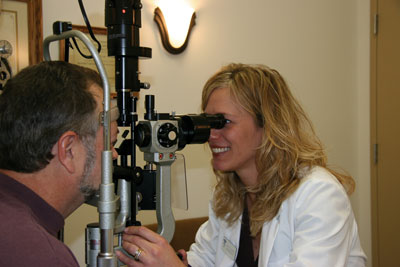
Barbara Fluder, O.D., decided to quit after 11 years of corporate and start up cold so that she could expand her practice and treat patients medically.
In the Plan
Most of these optometrists say that they always planned to go into private practice. Only, their plans didnt quite go as expected.
When I graduated (from Pennsylvania College of Optometry) in 1995, this was not the setting I wanted, says Matthew Mignona, O.D., who worked in a U.S. Vision unit located in a J.C. Penney store in Allentown, Pa. But, I did not have a practice opportunity that turned my head.
He says that the situation there was acceptable; he set his own hours, and he had no quota of patients to see. You could say I got a little bit comfortable. They didnt hassle me. I was still looking for opportunities, but not actively, he says.
Dr. Fluder, a 1993 graduate of Indiana University School of Optometry, was working for U.S. Vision in a J.C. Penney store in
When optometrist Jim Kelly graduated from Indiana University School of Optometry in 1991, he interviewed with private practices. He went to work for a group practice with the understanding that he would eventually buy into it, but things didnt turn out as he expected. I had reached a point of frustration, and then Wal-Mart called me, Dr. Kelly says.
Specifically, Wal-Mart was opening a new store and needed an O.D. in a week. Eleven years later, I was still with Wal-Mart, he says.
The Grind
In time, these O.D.s began to chafe under retail management especially under the hours, case volume, product selection and optical staff.
Chad Millsap, O.D., worked at Pearle Vision for five years after graduating from Illinois College of Optometry (ICO) in 2001. He worked part-time at Pearle and part-time with a private practice. Initially, Dr. Millsap says, he enjoyed the patient volume at Pearle because he had only seen a limited number of patients at ICO.
That changed. I began to feel worn down by the average day, which was a total of 30 patients15 to 25 exams, plus follow-up visits, he says. Now, I realize that a lot of Pearles are controlled by business people, not doctors. Its not that the patient care isnt good; patient care just isnt the number one priority.
Optometrist DeAnne Witherspoon and her husband David, also an O.D., were some of the first optometrists to sign a lease with Wal-Mart 16 years ago. Located in
Back then, Wal-Mart was recruiting doctors and making us happy, Dr. DeAnne Witherspoon says. That worked for us. They provided us with every piece of equipment we needed or wanted. But, those relationships that helped the doctor arent there anymore.
In recent years, the Witherspoons became frustrated with the quality of the optical staff and management. The turnover in optical is frequent, from the headquarters right down to the vision center managers and associates, Dr. DeAnne Witherspoon says. We need to have confidence in vision center staff, but due to turnover, that is difficult. The optical people dont work for us, but we need to have a team relationship.
She adds that the corporate culture has changed. We used to have a say in a lot of things because they asked our opinion. But, as Wal-Marts opticals became bigger, we had no say. We were not even allowed to express an opinion. (She and her husband still practice at Wal-Mart, but also operate a private practice.)
Dr. Kelly also says that his relationship with Wal-Mart changed over time. Most of the time, I practiced without interference, he says. Then, they ramped up the pressure. They wanted me to see more patients but wouldnt provide more staff. I couldnt trust the staff because they didnt work for me. The writing was on the wall.
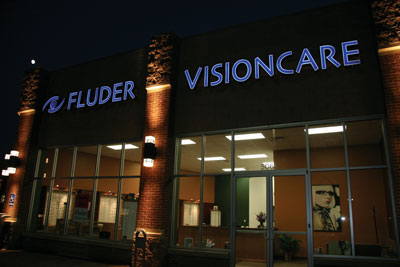
For Dr. Fluder, it was all about location. So, her new office is in a retail center near other health-care professionals.
Dr. Fluder, who practiced at J.C. Penney for 11 years, felt that she had built up a good practice but could not take it in the direction she wanted to go in the future, namely treating patients medically and billing medical plans. My practice had grown so much, and we just ran out of room, she says. I wanted to expand my scope of practice, but I was limited by space. There was no room for equipment. I couldnt provide pachymetry or optic nerve fiber analysis.
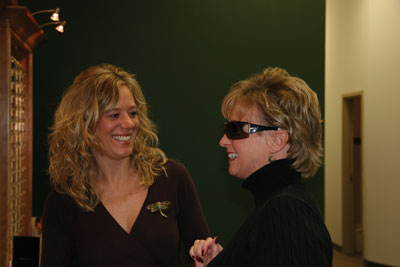
Dr. Fluder had great patient exposure working in a corporate setting, she says, but she wanted the opportunity to grow her own practice.
Turning Point
Each of these O.D.s describes a turning point that moved him or her toward private practice. Sometimes the turning point was apparent; other times, it occurred later.
A friend of mine advised me to look for space that had previously been occupied by a medical professional, Dr. Kelly says. Then, a good location became available near my dentist. It had been occupied by a chiropractor. It was like the skies parted and a ray of light came down.
Another fortuitous event moved the process forward. An optometrist in the area was closing a second location, so Dr. Kelly purchased the equipment and furnishings. That, combined with the easy build-out on the new office, enabled him to open his practice in less than two months.
Dr. Fluder also found an ideal location near where she used to practice. (She did not have a non-compete agreement with her former practice.) Everything fell into place, she says.
Dr. Fluder describes location as the highest priority. Her new 2,400-square-foot office is in a retail center, along with two other health-care professionals (a dermatologist and a dentist).
In Dr. Mignonas case, an existing practice became available from a retiring doctor. His setup was appealing. I had already decided I didnt want to work with or for someone, Dr. Mignona says. Also, I wanted a professional setting with an established optical, and I wanted to own the building. This was all available. Dr. Mignona and his wife, Dana, also an O.D., have been in practice for three years.
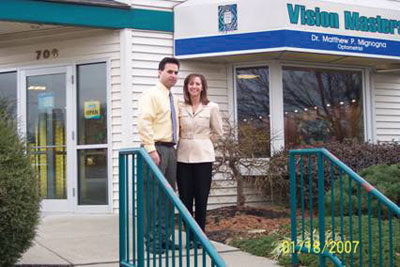
Drs. Matthew and Dana Mignona opted to purchase an established practice from a retiring optometrist.
For Dr. Millsap, the moment was when he realized that the private practice where he was employed part-time (along with part-time work for Pearle Vision) would not yield an ownership opportunity. I could tell it would never happen. Thats when I said I would do my own thing, he says.
He teamed up with an ICO classmate, Staci Lynn, O.D., who also wanted to start a practice, and they began shopping for a location. It took so long to find a place, Dr. Millsap says. We negotiated for three places; they all fell through. It was so frustrating.
The fourth time was a charm, and theyve been in business since last summer.
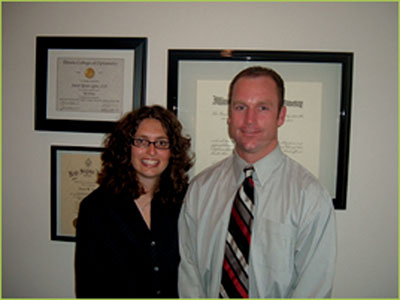
Chad Millsap, O.D., and Staci Lynn, O.D., wanted the opportunity to own their own practice. After a rough start, they found a location, and they opened last summer.
The Big Nut
Although a desirable location is crucial to establishing a practice, the big nut is financing. Where does the money come from? For these O.D.s, it came from personal savings, home equity, bank loans and private financing. These doctors report that finding the money was not that difficult, possibly because they were more financially established than new graduates.
We borrowed against our house, Dr. Kelly says. When a friend would stop by to see the office, I would joke, Youre sitting in my living room. I felt confident of my future, so we used our home equity to our advantage. His total debt was $120,000.
Dr. Millsap and his partner split the investment, each putting in $45,000. For his portion, he used $10,000 of his own money, and borrowed the other $35,000 from HSBC, a lender that specializes in health-care practices.
When the Witherspoons decided to open their practice one year ago, they borrowed money from a local bank. Nothing was difficult about it, says DeAnne Witherspoon.
Because Dr. Mignona was buying an existing practice that had a large patient base and real estate, the investment was larger. He needed about $1 million to buy the practice and building. The number was big, and it seemed overwhelming at first, he says.
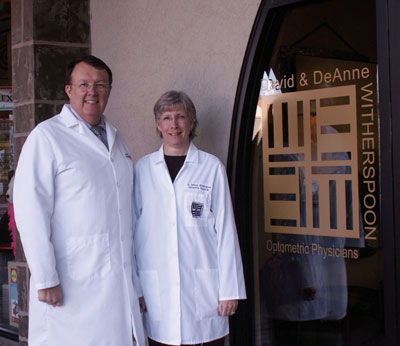
Drs. David and DeAnne Witherspoon still practice in a corporate setting in
He approached a bank and the practice owner, and ended up with about 50% financing from the bank and 50% from the seller. The building had a big value, and that helped to secure the bank financing. It meant a lot to me that the selling doctor would finance so much of it, because it showed that he believed it was a viable practice, Dr. Mignona says.
Cost-Cutting
Along with securing financing, several of these O.D.s said they worked hard to keep initial costs down.
We knew we were on a tight budget, so we did a lot ourselves, Dr. Millsap says. My dad painted the office. We put off some equipment purchases (such as an autorefractor) until we could afford them. We were as frugal as possible.
Dr. Kelly bought reconditioned equipment rather than new and acted as his own IT consultant. I built my own computer network, he says. My wife, Mary Beth, is a fabulous decorator, so she chose the color scheme and put artwork on the walls. We went to IKEA for furniture, and we got creative.
Dr. Fluders practice benefited from a helpful spouse as well. My husband, John Oberman, wasand isvery involved; he is my IT person. He is a computer engineer and has a masters degree in English. He designed my Web site (www.fludervisioncare.com) and is great with advertising and marketing, she says.
Just Do It!
Every one of these O.D.s has the same advice for any colleague who would like to leave a corporate practice for a private one: Just do it!
They all report significant jitters about the financing and the age-old question: What if no one comes in the door? But, their worries did not become reality. All five say that revenue is ahead of their expectations, and several already have three to five employees. In a few cases, they are employing a part-time O.D.
Emotionally, its very rewarding, but there is a lot of stress, Dr. Mignona says. Everything is running through your mind. Its hard to sleep at night. But, the best part is knowing it is your own and making it work.
Dr. Witherspoon sums it up: Now we will have a practice to sell when we retire, and we can pass our patients on to someone we can trust. Its the best thing for us and for our patients.
Advice for the Entrepreneur Here is some additional advice these doctors have to offer for starting a practice: Do not obsess over any one problem or challenge. Do your research, make your best educated decision, and then move on to the next challenge. Be judicious about the money you spend at first. Ask yourself whether a piece of equipment will pay for itself. If not, you can always purchase it later. Be conservative about accepting insurance plans. "Slow pay" can seriously hurt a fledgling practice. Set fees that place you in a niche between the chains and high-end professional. Select eyewear that places you in a similar niche. Work on building word-of-mouth advertising. Go slow with any big investment in advertising. Invest in a professional logo and stationery. This will get you more "bang for the buck" than other marketing investments. Cultivate friendships with other successful health-care practitioners, particularly those who are good at marketing. Get out there and "meet and greet." Join the Chamber of Commerce; you should get a new patient out of every meeting.

